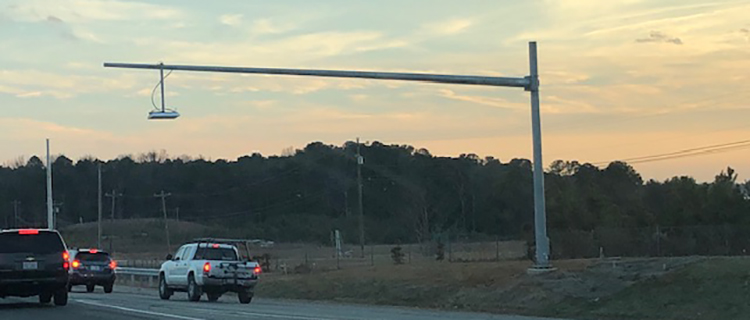
What exactly are they learning?
By Debbie Griffin. Drivers in Cornelius and throughout the I-77 corridor have questions about the L-shaped poles installed in recent weeks at entrance and exit ramps along the interstate’s general lanes, which are part of the 26-mile, $647 million Express Lanes project.
Commuters have questions about the technology, including Cornelius resident Michelle Ferlauto, who asked if there are cameras up there and said, “I just don’t understand why anyone would want to know when you’re turning off the interstate?”
Carly Olexik, public relations officer for the North Carolina DOT and Turnpike Authority; her associate Hillary DeLong; and Jean Leier, director of corporate affairs for I-77 Mobility Partners, provided information, as well as the North Carolina DOT and Turnpike Authority websites. All three entities are involved in the project through a series of complex contracts and partnerships, each with specific responsibilities.
What are the things at the top of the poles?
The rectangular-shaped contraptions are “non-toll AVI (automatic vehicle identification) readers.”
Are there cameras in the readers?
No, Olexik and Leier confirm the AVI readers do not contain cameras.
Why is toll technology being installed at general-use exits and entrances?
In short – traffic analysis, future planning and dynamic toll setting all play into the picture. Leier said the AVI data “provide a better picture of how drivers use the highway in the express and general-purpose lanes to help provide traffic pattern data.” She said the more vehicle movements can be tracked as they enter, travel and leave the highway, the better the DOT can prepare to improve their experience.
How are toll facilities different than the readers?
DeLong said the all-electronic toll-reading technology is situated in a “toll gantry” capable of reading the microchipped transponder embedded in toll tags and can take pictures of license plates.
What entity owns and keeps collected data?
Olexik said the North Carolina Turnpike Authority collects, manages and secures only the toll-account data; project partner I-77 Mobility Services is responsible for the AVI technology and data. Olexik and DeLong said the toll authority does not share or grant access to its data at all. Leier said I-77 Mobility Partners “does not have access to personal information.”
What information do the readers collect?
Leier had said in an e-mail: “Those are non-toll AVI readers. They read transponders, however they are not connected to the tolling system.” Their purpose is to provide additional traffic information and movements that other vehicle counters can’t provide. DeLong described what the readers do as more of a ping than the full read and pictures that happen at a toll gantry.
Do the AVI readers pick up any information from cars that don’t have a toll tag?
No they don’t, Leier said.
What information does the Toll Authority ask for when setting up an account?
Information requested when opening a toll-pass account includes name, address, email and phone number, license-plate numbers and the year/make/model of up to five vehicles. Toll accounts require a user name, password, security questions and personal-identification number, as well as credit-card information for prepaid accounts.
NC has three, basic types of toll passes
1. NC Quick Pass is an interior, card-sized sticker for cars and an exterior sticker for motorcycles. Drivers open a prepaid account and receive the transponder free.
2. E-Z Pass bumper: A bumper-mount sticker costs $13.49 and works when a windshield-mounted tag will not and is also a prepaid account.
3. E-Z Pass Flex: A windshield-mounted transponder in a hard case that costs a driver $16.49. When a Flex-pass customer has three or more occupants in the car, they can flip a switch and 15 minutes later, jump into the express lanes for free, like an HOV lane.



